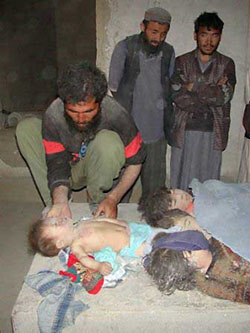Cluster Bomblets Litter Afghanistan
Human Rights Watch, November 16, 2001
 | |
More photos |
(New York, November 16, 2001) Nearly 5,000 unexploded and highly volatile cluster bomblets may be littered across areas of Afghanistan that were targeted by U.S. warplanes, Human Rights Watch said today.
"These unexploded bomblets have in effect become antipersonnel landmines," said Mark Hiznay, senior researcher of the Arms Division of Human Rights Watch. "They pose an extreme hazard to civilians, not just now but for years to come." Human Rights Watch repeated its calls for the United States to immediately stop using cluster bombs in Afghanistan.
Human Rights Watch learned from U.S. military sources that as of last Thursday, November 8, 2001, the U.S. had used 350 cluster bombs in the air campaign in Afghanistan. Of these, 150 were the CBU-87 Combined Effects Munition; the remaining 200 were the CBU-103, a recent variant of the CBU-87 with the Wind Corrected Munitions Dispenser kit added to make it more accurate. Each CBU-87 and CBU-103 releases 202 BLU-97 bomblets over a wide area, dimensions of which are dependent on several factors such as release altitude, spin rate of the munition, and wind speed.
This means that 70,700 BLU-97 bomblets have been dispersed from these 350 cluster bombs. The BLU-97 bomblets have a high initial failure rate, meaning an unacceptably large proportion fail to explode on contact as designed. These unexploded duds remain highly unstable, capable of exploding on the slightest disturbance or contact. They become, in effect, antipersonnel landmines. BLU-97 duds have led to high casualty rates in Iraq and Yugoslavia following the conflicts there.
Using a 7 percent initial failure rate for the BLU-97 bomblet, an estimated 4,949 hazardous duds may now be littering areas in Afghanistan where these cluster munitions have been dropped. Historically, the failure rate of submunitions can range from 5 to 30 percent depending on the type of munition used and other operational and environmental conditions. Human Rights Watch obtained the 7 percent failure rate for BLU-97 bomblets from statistical reports by the United Nations Mine Action Coordination Center in Kosovo on unexploded ordnance and mine clearance operations in Kosovo since June 1999.

In Afghanistan alone, about 20 innocent civilians including children and women, daily fall victim to mines, half of whom loss their lives due to lack of medical facilities. Due to the presence of mines, access has been denied to more than 488 square kilometer of land, including agricultural fields, irrigation canals roads and residential areas. Over 30% mine victims in Afghanistan are children. The legacy of that long war also included 750,000 amputees The UN figure for the number of Landmines in Afghanistan at 10 million. There are more than 600,000 landmines to be cleared while the warring factions are still laying more. |
The unexploded BLU-97 bomblets are yellow soda-can-size objects. The U.S. Defense Department, acknowledging on November 1, 2001 the tragic possibilities of confusing these objects with similarly colored food packets, began dropping leaflets warning the civilian population of the danger and also announced it would change the color of the food packets.
Human Rights Watch welcomes the step of changing the color of the food packets and the efforts to warn the population, but stresses that it hardly solves the enduring problem of unexploded dud cluster bomblets.
The United Nations office in Islamabad has so far publicly confirmed one civilian death and three civilian injuries (including two children) from handling unexploded cluster bomb duds in the villages of Eshaq Sulaiman Zai and Shakar Qala. The manager for the U.N. Mine Action Program for Afghanistan at a November 9, 2001 news conference also stated the coalition force is being cooperative and is providing some information on locations of strikes, which may contain unexploded ordnance.
"The United States will have a special responsibility to clean up the unexploded submunitions and other unexploded ordnance once the fighting stops," Hiznay said. "The U.S. should make available the necessary information and resources so that this can be done promptly and safely." NATO eventually provided to the U.N. Mine Action Coordination Center in Kosovo a database of all of the locations where they knew cluster bombs had been used.
For more information on the use of cluster bombs in Afghanistan, please see:
Cluster Bombs in Afghanistan (HRW Backgrounder, October 2001) at
http://www.hrw.org/backgrounder/arms/cluster-bck1031.htm
International Humanitarian Law Issues and the Afghan Conflict (HRW
Letter, October 17, 2001) at
http://www.hrw.org/press/2001/10/nato1017-ltr.htm
For more information on human rights in the aftermath of the September
11 attacks on the United States, please see:
September 11 Attacks: Crimes Against Humanity (HRW Focus Page) at
http://www.hrw.org/campaigns/september11/